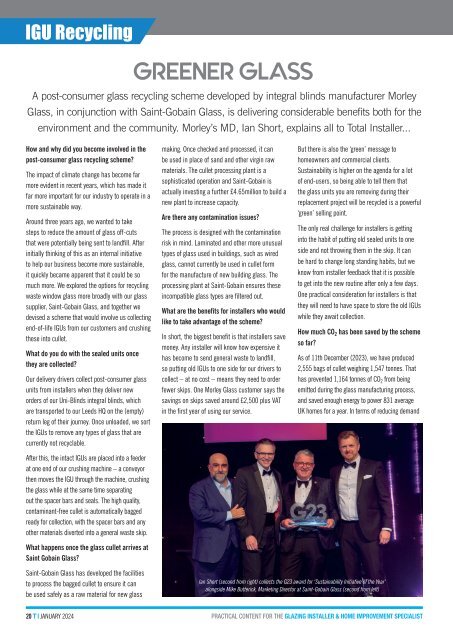January 2024
You also want an ePaper? Increase the reach of your titles
YUMPU automatically turns print PDFs into web optimized ePapers that Google loves.
IGU Recycling<br />
GREENER GLASS<br />
A post-consumer glass recycling scheme developed by integral blinds manufacturer Morley<br />
Glass, in conjunction with Saint-Gobain Glass, is delivering considerable benefits both for the<br />
environment and the community. Morley’s MD, Ian Short, explains all to Total Installer...<br />
How and why did you become involved in the<br />
post-consumer glass recycling scheme?<br />
The impact of climate change has become far<br />
more evident in recent years, which has made it<br />
far more important for our industry to operate in a<br />
more sustainable way.<br />
Around three years ago, we wanted to take<br />
steps to reduce the amount of glass off-cuts<br />
that were potentially being sent to landfill. After<br />
initially thinking of this as an internal initiative<br />
to help our business become more sustainable,<br />
it quickly became apparent that it could be so<br />
much more. We explored the options for recycling<br />
waste window glass more broadly with our glass<br />
supplier, Saint-Gobain Glass, and together we<br />
devised a scheme that would involve us collecting<br />
end-of-life IGUs from our customers and crushing<br />
these into cullet.<br />
What do you do with the sealed units once<br />
they are collected?<br />
Our delivery drivers collect post-consumer glass<br />
units from installers when they deliver new<br />
orders of our Uni-Blinds integral blinds, which<br />
are transported to our Leeds HQ on the (empty)<br />
return leg of their journey. Once unloaded, we sort<br />
the IGUs to remove any types of glass that are<br />
currently not recyclable.<br />
After this, the intact IGUs are placed into a feeder<br />
at one end of our crushing machine – a conveyor<br />
then moves the IGU through the machine, crushing<br />
the glass while at the same time separating<br />
out the spacer bars and seals. The high quality,<br />
contaminant-free cullet is automatically bagged<br />
ready for collection, with the spacer bars and any<br />
other materials diverted into a general waste skip.<br />
What happens once the glass cullet arrives at<br />
Saint Gobain Glass?<br />
making. Once checked and processed, it can<br />
be used in place of sand and other virgin raw<br />
materials. The cullet processing plant is a<br />
sophisticated operation and Saint-Gobain is<br />
actually investing a further £4.65million to build a<br />
new plant to increase capacity.<br />
Are there any contamination issues?<br />
The process is designed with the contamination<br />
risk in mind. Laminated and other more unusual<br />
types of glass used in buildings, such as wired<br />
glass, cannot currently be used in cullet form<br />
for the manufacture of new building glass. The<br />
processing plant at Saint-Gobain ensures these<br />
incompatible glass types are filtered out.<br />
What are the benefits for installers who would<br />
like to take advantage of the scheme?<br />
In short, the biggest benefit is that installers save<br />
money. Any installer will know how expensive it<br />
has become to send general waste to landfill,<br />
so putting old IGUs to one side for our drivers to<br />
collect – at no cost – means they need to order<br />
fewer skips. One Morley Glass customer says the<br />
savings on skips saved around £2,500 plus VAT<br />
in the first year of using our service.<br />
But there is also the ‘green’ message to<br />
homeowners and commercial clients.<br />
Sustainability is higher on the agenda for a lot<br />
of end-users, so being able to tell them that<br />
the glass units you are removing during their<br />
replacement project will be recycled is a powerful<br />
‘green’ selling point.<br />
The only real challenge for installers is getting<br />
into the habit of putting old sealed units to one<br />
side and not throwing them in the skip. It can<br />
be hard to change long standing habits, but we<br />
know from installer feedback that it is possible<br />
to get into the new routine after only a few days.<br />
One practical consideration for installers is that<br />
they will need to have space to store the old IGUs<br />
while they await collection.<br />
How much CO 2 has been saved by the scheme<br />
so far?<br />
As of 11th December (2023), we have produced<br />
2,555 bags of cullet weighing 1,547 tonnes. That<br />
has prevented 1,164 tonnes of CO 2 from being<br />
emitted during the glass manufacturing process,<br />
and saved enough energy to power 831 average<br />
UK homes for a year. In terms of reducing demand<br />
Saint-Gobain Glass has developed the facilities<br />
to process the bagged cullet to ensure it can<br />
be used safely as a raw material for new glass<br />
Ian Short (second from right) collects the G23 award for ‘Sustainability Initiative of the Year’<br />
alongside Mike Butterick, Marketing Director at Saint-Gobain Glass (second from left)<br />
20 T I JANUARY <strong>2024</strong> PRACTICAL CONTENT FOR THE GLAZING INSTALLER & HOME IMPROVEMENT SPECIALIST
















